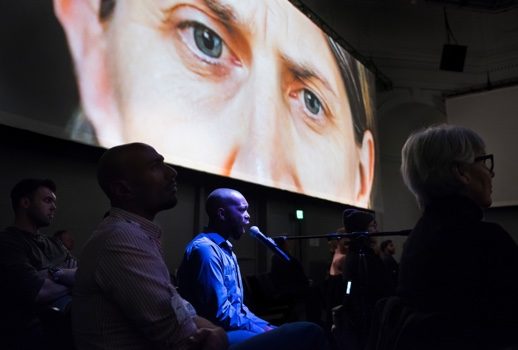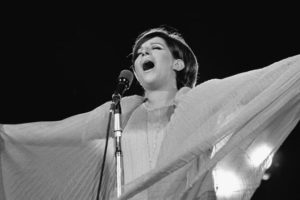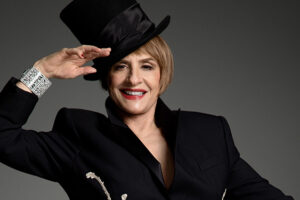

Bringing Hearne’s collage-like compositional process and combination of acoustic and electronic elements to the weighty topics of national security leaks, big data, and war, The Source is currently in its third production at SF Opera Lab.
The Source remains a tightly curated affair, with all four vocal ensemble roles played by the original cast (Melissa Hughes, Samia Mounts, Isaiah Robinson and Jonathan Woody), and Hearne and director Daniel Fish present to supervise each show. More than half of the seven-member instrumental ensemble in the SF Opera Lab performance, including the conductor, were also featured in the 2015 studio recording of the work. Owing both to the consistency of the artistic team and the opera’s structure (written for a role-less ensemble cast with frequent electronic distortions and enhancements) there is little point in divorcing the composition from the act of performing it.
I will try here to give the reader both a road map for what to expect out of the work, and some of my observations as to its effectiveness. At the macro level, The Source, both in librettist Mark Doten’s compiled text and Hearne’s realization of it, is a fascinating concept that suffers from trying to do too many things at once. I left the opera wondering what it had been about: The challenge of parsing enormous amounts of information in the digital age? The secretive conduct of US foreign policy? The dehumanizing nature of big data? The role of Pvt. Bradley Manning or Julian Assange in the Wikileaks affair?
At times, the work seemed to try to tackle all four. It did so, however, with varying levels of success. Its explorations of the first two of those questions rung far truer to me than the last two. And its attempts to combine these many threads into one whole created more diffuseness than complexity. When it came to the music itself, the piece was classic Ted Hearne–making virtuosic use of unconventional compositional techniques to create a dreamlike atmosphere of dislocation and unrest. His expertly-selected ensemble executed his vocally and rhythmically demanding score with seeming ease.
This oratorio was presented in SF Opera’s Taube Theater, a versatile, high-ceilinged square space on the fourth floor of the opera’s administrative building (next door to their usual venue at the War Memorial Theater). This whole large space was divided into two triangular seating sections, each side facing the other. The upper portion of the wall on each side of the square held a scrim for projections, and the orchestra (composed of one violin, one viola, and one cello, keyboard, guitar, electric bass, and drums) sat on an elevated platform behind one of the scrims, visible to the audience only in silhouette. The four-singer ensemble sat among the audience, one in each corner of the room.
Throughout the opera, each screen showed projected videos of the faces of a varied cast of characters from the streets of Brooklyn. The silent videos were taken while the New Yorkers were shown the infamous gun sight video of two Reuters journalists who were shot out of an Apache helicopter in 2007–the episode to which Wikileaks, which released the video, affixed the sensational moniker “Collateral Murder.” During some of The Source’s more climactic moments, the faces showed overt emotion, but they usually remained understated–evincing perhaps only a slight furrow of the brow.
Fish rotated the faces throughout the performance, at times adding additional faces and taking others away. At the conclusion of The Source, the audience was shown the same video that the projected on-screen viewers had seen–and due to the facing seating configuration, we were left watching each other’s faces as the lights came up, just as we had formerly watched those on the screens.
The music itself was a vintage Ted Hearne affair. Lurching between Janacekian string dissonances, Stravinskian thorny rhythms, ‘90s rock tropes, R&B, and recorded samples taken from musical sources as diverse as Liz Phair and Dinah Washington, the work was a study in his technique of musical “collage.” The libretto, compiled primarily from snatches of Iraq and Afghanistan incident reports released by Wikileaks, was presented as a series of deadpan electronically-enhanced recitatives set alongside arias that exhibited Hearne’s signature collage style. The net effect of this style of presentation, both by its decontextualized concept and uncomfortably banal delivery, was exactly as Hearne described in the opera’s subtitle, “Unsettlement Music.”
Hearne has stated in multiple interviews that his intention was to present the text in a way that emphasized its emotional distance from the observer–and in his hands it becomes a bewildering tapestry of numbers and code words. The at times odd emphases of the recitative texture (coming to emphatic musical rest, in one example, on the otherwise insignificant name of Afghan Premier Hamid Karzai) makes us all too aware of one person’s inability to process such an enormous amount of information meaningfully.
But the occasional coincidence of musical rest with a moment of actual poignancy–like the word “windshield” at the end of a report about a marine who opened fire on a vehicle despite being unable to tell the identity of its occupants due to the glare–kept us aware that in between all the banalities, there was much at stake here.
Central in this musical atmosphere was Hearne’s use of a sophisticated version of Autotune, which served the dual purpose of clarifying the piece’s harmonic structure, and distorting the voices. (For those with special interest in the musical substance: the specific pitches amplified by Autotune were finely controlled and frequently in flux. The Autotune would often change pitch profile within a single movement, and would also change with respect to the “Wet/Dry Mix”–the volume ratio between the singer’s natural voice and Autotuned voice).
The Autotune method reached its expressive zenith in the penultimate movement “We called for illumination at 1630,” in which the electronic enhancements worked in perfect concert with the high-range virtuosity of the singers, particularly tenor Isaiah Robinson. The effect (heavy-handed double entendre of the title aside) was a euphoric marriage of naturally and artificially generated sound.
Interspersed among the war log “recits” and “arias” were a few movements that aimed to give the audience a lens on the key personalities behind the Wikileaks affair–Manning and Assange. Manning’s arias took the form of settings of one-line extracts from online chats with Adrian Lomo, the hacker who ultimately turned Manning over to the authorities. Manning’s voice, sung alternately by male and female vocalists, spoke in short snatches both of discomfort both with American foreign policy and his own gender.
Hearne’s style of overwhelming the ear, so valuable in capturing the enormity and inscrutability of the leaked documents, however, proved a hindrance when it came to defining character. While composition by collage had succeeded in building the atmosphere of “dislocation” of the enormous digital world, it failed when it came to depicting the complexity of a single human soul. With such a cursory treatment of Manning’s own story, I almost found myself wondering why the movements were even there.
The opera’s approach to Assange, however, was more striking and successful. In the sixth movement, “Julian in a Nutshell,” Doten etched out the elusive international outlaw’s personality by filling the text entirely with questions asked of Assange in media interviews. Hearne’s nearly cacophonous setting of the interview questions in rapid succession–trailing off at the movement’s conclusion with “Are you a journalist? What do you want?” effectively established Assange as a not-quite-understood but omnipresent force behind the scenes.
On the whole, Hearne’s composition and Fish’s setting achieved one of its primary goals with great success: portraying the sheer enormity of the world of data in the digital age, and the almost paralyzing helplessness of an individual trying to confront that world. This success was due in no small part to the masterful ensemble performances of the vocalists (in particular the performance of tenor Robinson, a Chicago-based charter member of the Hearne Mafia, whose incisive upper-range Hearne regularly employed to build musical drama and tension).
The seven-member instrumental ensemble directed from the keyboard (and MIDI controller) by Nathan Koci did a near-perfect job of negotiating Hearne’s rhythmically complex and multi-dimensional score. The string section of Jennifer Cho on violin, Natalia Vershilova on viola, and Emil Miland on cello achieved a particularly glorious sound in the tender close harmonies of the ninth movement, “Smoke when bird nears.”
Despite the opera’s success at communicating the big data theme visually and aurally, however, that success was overshadowed by its inability to connect that thematic thread to the other threads in a meaningful way. In interviews, Hearne has been candid about the fact that the seeds of a Wikileaks opera were planted well before Manning’s part in the story was fully known. That was painfully apparent.
To borrow a term from Manning’s world, the opera seemed to have suffered from “mission drift”–changing circumstances which blurred the work’s original intentions over time. The final movement, which attempted to fuse the themes together by layering Manning’s chat text on top of Wikileaks incident-report text, amounted only to a declaration that the two themes were connected without an explanation of how or why.
Finally, as a footnote, there is the matter of the opera’s rather strange point of view. I do not begrudge Hearne bringing his “concerned civilian” (albeit bougie hipster civilian) perspective to this issue and portraying it in a way that romanticizes leakers and whistleblowers. However, Hearne and Doten’s implied interpretation of the Wikileaks data’s “dehumanizing” content as evidence of some sort of moral decrepitude in twenty-first century America strains credulity.
Doten, in his program notes on the libretto, writes that The Source “is a negotiation between individuals and a massive quantity of information–information written specifically to obscure the personal, to transform the stories of life and death in a theater of war into neutral bureaucratic data.” The accusatory tone of the words “bureaucratic” and “neutral” almost makes us wonder whether Doten and Hearne actually expected institutional records to be written as literature for their consumption and enjoyment.
While an unprecedented level of impersonality is a central feature of modern warfare, the use of “dehumanizing” military records as a symbol of this impersonality makes little sense. Military records were not any less impersonal fifty years ago, or five hundred. And I doubt that reading the log of a whaling vessel from the 1700s (“Man overboard in the morning. Hardtack for supper.”) would make us despair any less for humankind than the reams of military reports published by Wikileaks!
But regardless of the wisdom of Hearne, Fish, and Doten’s perspective on the leaks themselves, the strength of their work comes in its ability to make the audience critically engage with these questions. And as the lights came up in the end, and I found myself gazing at the faces of the audience sitting across from me, I keenly felt the piece’s intention to serve as a mirror for its audience, forcing us to examine ourselves and each other. In that spirit, I wholeheartedly recommend devoting an hour of your time to this fresh while imperfect opera/oratorio.
Photo Credit: Stefan Cohen























Comments